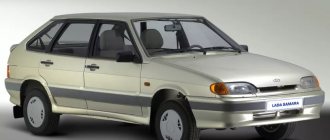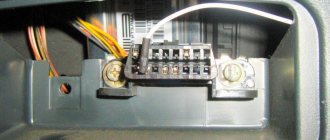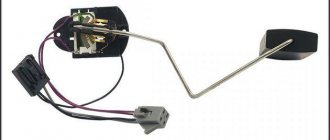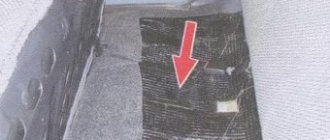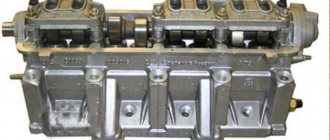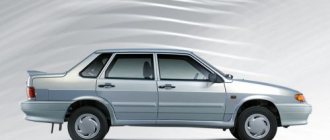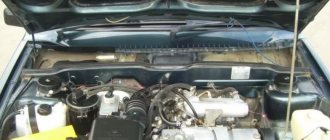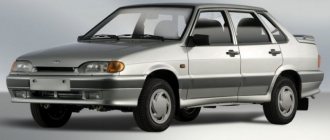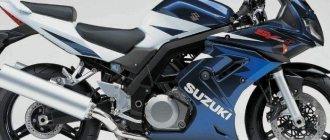Tell me, from what year have the injectors been installed in Samara?
I would like to know, I looked on the internet but couldn’t find it (((
in 97 they already started installing GM in the light
Can you tell me what year the Bosch injector came from?
Boshiki since 2000, although the software is from 1999
Well, since the 97th, some have GM, and some have the usual 4th January. Now you have to suffer with it
What do you mean, suffer? I heard about GM that sensors are expensive and difficult to find, but why is January bad?
it’s old, not all specialists have adapters for it, spy actually said that it doesn’t repair such little animals, one sensor costs as much as the entire set of a modern injector
How can you distinguish January from Bosch (during inspection, when purchasing)?
Which January do you want to cure?
It was a 1998 08 and had GM on it.
Not so long ago I read somewhere that VAZ began testing the first Inzhiki in 1994. And they went into production in 1996. I myself am the owner of a 98 with a Bosch 1.5.4 controller.
Was 2109 1998, GM injector, worked perfectly, and still works to this day. There were no problems at all.
You may be as powerful as the Lord God himself, but once someone is found who has the courage to put a hole in your head, you will go to the other world like all other mortals. ” © Don Vitto Corleone.
I just want to buy a Samara from the year 98-99, I want an injection one, so I’m wondering how not to fly by and take it with a normal injector so that later I don’t have to worry about looking for sensors, and I could chip it
well, no one can tell you how to visually distinguish an injector
And here are the labels on the controllers:
Is January a bosh? Or not? And what are the disadvantages of January?
check which unit is in the car. for example, in a classic injection engine, the control unit is located in the area of the passenger side boarding compartment, just below the boarding compartment; in front-wheel drive, I don’t know for sure, but it’s fastest there. in general, on each electric block. control there is a marking to which manufacturer it belongs.
Bosch is not January. These are 2 different controllers. The most normal January is episode 5, I don’t remember all the letters, you can look it up on the Internet. You can do whatever you want with it and there won’t be any problems. There is also January 7th. It is impossible to say that Bosch is better or worse than January since they are almost identical. The same eggs in profile.
Since the preferred year of the car is quite shaggy, I think that it’s worth paying attention first of all not to what kind of controller it has. In my opinion, it doesn’t matter. It might be better to choose a cleaner and straighter body. And to hell with this injector. I had a 99 95. with GM injector, re-export from Germany.
If nothing has been altered, then visually under the hood: 1) a knock sensor with one wire and without a BOSCH 1.5.4 oxygen sensor (simultaneous injection); 2) DD with two wires but without an oxygen sensor and absorber January 5.1.1 (simultaneous injection); 3) DD with two wires with an oxygen sensor (and if not thrown out with an absorber) BOSCH 1.5.4N, January 5.1 (pair-parallel injection).
Z.Y. checking the stickers on the controller is problematic given their availability; not every owner will agree to unscrew the panels to look at the controller.
And of the 3 presented above, which controller is not chipped?
Source: www.autosaratov.ru
LADA 2109
Hatchback
In the Soviet automobile industry, the “nine” had to become the first in many ways. Before the VAZ 2109, not a single domestic automobile company had modifications of the base model with a different number of doors. A pilot batch of 159 five-door hatchbacks was assembled by AvtoVAZ's experimental production department at the end of 1986. “Nine” became the first basic model of AvtoVAZ, the platform of which underwent design changes during mass production. The five-door hatchback was the first to receive standard hydraulic headlight levelers, headlight wipers, a rear window wiper and a rear windshield washer.
Initially, the VAZ 2109, built in 1987, had a short wing and a plastic mask - a beak-muzzle. Despite the criticism, the Lada Samara/Sputnik family featured the most modern design among domestic cars at the time of release. However, the angular geometry of the 1988 VAZ 2109 already in the early nineties began to differ unfavorably from the constantly modernized foreign models. To maintain demand for domestic cars in foreign markets, constant changes were made to the models of the Lada Samara family. Already in 1991, Tolyatti engineers began the Samara-2 project, which involved a radical restyling of the family. The updated five-door hatchback received the VAZ 2114 index and was produced on the main assembly line in parallel with its predecessor VAZ 2109 until 2004.
In the spring of 1989, the VAZ 2109 began to be modernized. The five-door hatchback lost its beak and decorative plastic trim in the corner of the third side window and received the so-called long wing. Versions with short wings continued to be assembled on the AvtoVAZ assembly line until 1994. The 1989 VAZ 2109 was assembled in versions with steel or plastic gas tanks. Instead of a 1.3-liter engine in the line of power units, the base engine was the new Togliatti engine of the VAZ-21083 series with a displacement of 1.5 liters.
Since 1990, the VAZ 2109 has received a new design for the front end - with a long wing without the characteristic “beak-mask” and with a new radiator grille, which has lost the horizontal slats protruding forward. The new grille had two longitudinal stripes with a wide edge. In the same year, the so-called The low dashboard came with a high one, designed for the VAZ 21099 sedan.
Another noticeable restyled change was the new 5-speed gearbox of the VAZ 2109 - also used for the first time in the Soviet automobile industry. A modification of the “nine” with a new 1.5-liter engine, a 5-speed gearbox, and a long wing received the in-plant index 21093. In the line of power units of the VAZ 2109 of 1992 and all subsequent years of production, the only 1.5-liter engine remained, the engines working volumes of 1.1 and 1.3 liters disappeared.
On almost all copies of the VAZ 2109, except for the very first ones produced before 1991, in order to increase passive safety, safety bars began to be installed inside the front side doors. As a matter of fact, the bars were originally included in the design of the Lada Samara/Sputnik family of models.
VAZ-2109 “Sputnik Samara”
Since 1987, production of VAZ-2109 models in a five-door hatchback body began. Compared to its fellow eight, the Sputnik/Lada Samara VAZ-2109 was considered a more respectable family car. This was affected by the presence of 5 doors and, as a result, a much less expressive appearance.
Since 1988, the ninth model, as well as modifications of this car (VAZ-21091 and VAZ-21093) have become the most popular front-wheel drive VAZ models. An even more successful modification of the ninth model was the VAZ-21093, which was produced in 1990.
If you fold the rear seats, the car could easily transform into a cargo-passenger version. It could be used as a station wagon. In the basic versions of the VAZ-2109, transversely mounted carburetor 1.3-liter four-cylinder engines with a power of 65 horsepower were installed. With these characteristics, a fully loaded car accelerated to 100 km/h in 18 seconds. The maximum possible speed is 156 km/h. The VAZ-21093 model was equipped with 1.5-liter engines (VAZ-21083) with a power of 72 horsepower. The VAZ-21093i model came with injection engines with a working volume of 1.5 liters. Plus, a modification of the VAZ-21091 was made, which was equipped with engines with a volume of 1.1 liters. Since the 90s, Luxury vehicles have been equipped with a newer instrument panel, which had a tachometer and a trip computer. And the newest development was a motor with a distributed fuel injection system.
In 1995, the front of the body was restyled. As a result, the radiator grille no longer melted. The last cosmetic modernization was carried out in 1997, however, the car’s equipment remained virtually unchanged.
The VAZ-2109 model and its modifications ceased production in 1997. This was due to the cessation of production of engines of the predecessor VAZ-2108.
About LADA 2109 engines 1st generation (1987 - 2011)
VAZ 2109 (Lada Samara), popularly known as a nine, is a five-door hatchback, a continuation of the Samara line. It was developed in 1987 using the three-door hatchback VAZ 2108 as a basis. The nine itself became the basis for the creation of the VAZ 21099.
The car gained wide popularity thanks to its fast design, good engines for those times, and a practical five-door body. All this, coupled with its low cost, as well as a wide selection of spare parts, made the VAZ 2109 very attractive. This attractiveness was passed on to its successor, the VAZ 2114. In contrast to the VAZ, the injector was installed as standard on the 2109 engines (power unit 2111).
In addition to the injector, the 2109 was equipped with a carburetor with a displacement of 1.1 l, 1.3 l and 1.5 l. Such engines can be seen if you look under the hood of the 2108.
In the article we will look at the engines themselves for the VAZ 2109, their characteristics and weaknesses.
ENGINE VAZ 2108
The 1.3 engine is the base for the eight, it was developed from scratch, and is structurally similar to the 21011 1.3 liter engine. there is nothing in common. This engine became the basis for the creation of power units for installation on the Samara family with a displacement of 1.1 liters and 1.5 liters. This is an in-line carburetor type engine, has 4 cylinders and an overhead camshaft. The timing drive uses a belt.
Regarding the service life of the engine, it is fair to say that careful and quiet operation, proper and constant maintenance will allow you to exceed the official 120 thousand km and the service life can be 180-200 thousand km.
In terms of disadvantages, the following are most often noted. The parts of the cooling system wear out quite quickly. Frequent oil filter replacement and valve adjustment will be required. Oil leaks often occur due to unreliable seals of the valve cover, fuel pump and distributor sensor. It should be noted that unreliable Solex-type carburetors in general, and EPHH in particular.
VAZ 2109
VAZ 2109 “Sputnik” (1986-1993)
VAZ-2109 “Sputnik”/Samara is a front-wheel drive passenger car with a hatchback body. Developed and mass-produced at the Volzhsky Automobile Plant in 1987-2006. From 2007 to the end of 2011, the VAZ-21093 version was assembled from vehicle kits in Ukraine. The car is a 5-door modification of the VAZ-2108 in the Lada Sputnik family of models. A five-door hatchback version, more endowed with the image of a “family” car. Once the most common model of the family.
History Edit
The car began production in 1987. Initially, the car was equipped with in-line 4-cylinder 8-valve carburetor gasoline engines with a volume of 1100, 1300 and 1500 cm³.
VAZ 21093 “Samara” (1990-2004)
In 1991, a new design of the “front” of the car was developed. Cars with such a front design began to be produced immediately after the start of production of the VAZ-21099 sedan. Since 1994, these cars also began to be equipped with 4-cylinder 8-valve VAZ-2111 1500 cm³ gasoline engines, which used a fuel injection system with distributed fuel injection.
In the Finnish version of the VAZ-2109 it was also possible to optionally install air conditioning, electric windows, power steering, and a sunroof.
The VAZ-2109 has two doors on each side, which makes it easier for passengers to get in and out compared to the two-door version; The central body pillar separating the doors has been shifted forward, thereby increasing the distance between the pillar and the rear seat cushion; The position of the upper seat belt attachment points has also changed - they are less restrictive when traveling.
A total of 1,615,995 units were produced. Subsequently replaced by the VAZ-2114 model.
VAZ engine injector: control system diagnostics
Before touching upon general issues of diagnosing the control system, it is worth getting acquainted with the controller lamp
If a malfunction occurs while driving the car, the controller will detect it and notify the driver using “CHECK ENGINE”, while storing in its memory the necessary codes about the nature of the malfunction. With their help, the process of diagnosis and subsequent repair of the fuel injection system will be facilitated. It is the controller that is able to coordinate the operation of VAZ sensors and systems that are part of the general composition of all fuel injection units.
A few words about the DST-2M digital tester.
It is used to diagnose the engine injection control system. It is worth remembering that only a competent specialist can make the correct diagnosis. No matter how much an inexperienced mechanic strives to automate the process of diagnosing a car, having the necessary tools, he will not succeed without certain skills, which can in some cases aggravate an already difficult situation.
Diagnostics includes the following steps:
- checking the fuel supply system, the operability of all sensors, actuators and the ignition system;
- reading fault codes;
- compression measurement;
- data monitoring of the entire control system.
Once the injector has been diagnosed, the entire range of necessary services becomes clear if it is associated with a failed electronic system responsible for the performance of the engine.
About the car in general Edit
- The layout of the VAZ-2109 is front-engine, front-wheel drive.
- The body of the VAZ-2109 is two-volume, hatchback type.
Lada Samara Baltic GL (21093-22) (1996-1998)
Engine - VAZ-2109 was equipped with a four-stroke in-line 4-cylinder gasoline engine VAZ-2108.
- Transmission - VAZ-2109 was equipped with a mechanical transmission, which included:
- Chassis - The front suspension of the VAZ-2109 is completely independent, MacPherson type, so-called. "floating candle" The rear suspension is semi-independent with a torsional transverse beam, similar in design to many other front-wheel drive cars of those years.
single disc clutch; five-speed gearbox; cylindrical main gear; bevel differential; drive shafts with CV joints.
Specifications
| Index | VAZ-2109 | VAZ-21091 | VAZ-21093-20i | VAZ-21093 |
| Total information | ||||
| Number of places | 5 | |||
| Number of seats with rear seat folded | 2 | |||
| Useful weight, kg | 425 | |||
| Weight of transported cargo, kg: | ||||
| with one passenger | 275 | |||
| for four passengers | 50 | |||
| Vehicle curb weight, kg | 945 | |||
| Turning radius on the outer wheel track, m | 5,2 | |||
| Maximum speed, km/h | 148 | 140 | 156 | 156 |
| Acceleration time from standstill with driver and passenger to 100 km/h, s | 16 | 17 | 12,5 | 13 |
| Braking distance of a vehicle with full weight from a speed of 80 km/h on a horizontal section of a dry, level asphalt highway, m, no more than: | ||||
| when using the service brake system | 38 | |||
| in case of emergency operation (only one of the circuits) | 85 | |||
| Engine | ||||
| Model | 2108 | 21081 | VAZ-2111-80 | 21083 |
| Type | Four-stroke petrol carburetor | |||
| Number and arrangement of cylinders | 4 in a row | |||
| Bore x stroke, mm | 76×71 | 76×60,6 | 82x71 | 82×71 |
| Working volume, l | 1,3 | 1,1 | 1,5 | 1,5 |
| Compression ratio | 9,9 | 9,0 | 9,9 | |
| Rated power at a crankshaft speed of 5550 min–1 (for engine mod. 21081 at 5500 min–1) according to GOST 14846–81 (net), kW (hp) | 46,6 (63,4) | 39,9 (54,3) | 51,5(70) | 51,5 (70,0) |
| Maximum torque according to GOST 14846–81 (net) and ISO1585–82, N m (kgf m) | 94,8 (9,66) | 77,9 (7,94) | 106,4 (10,85) | |
| Crankshaft rotation speed at maximum torque, min–1 | 3400 | 3600 | 3400 | |
| Cylinder operating order | 1–3–4–2 | |||
| Transmission | ||||
| Clutch | single-disc, dry with central diaphragm spring | |||
| Clutch release drive | cable backlash-free | |||
| Transmission | mechanical, 4- or 5-speed, with synchronizers in all forward gears. The main gear is cylindrical, helical. Differential bevel, two-satellite | |||
| Gear ratios (four-speed transmission has the same ratios, but without fifth gear): | ||||
| 1st gear | 3,636 | |||
| 2nd gear | 1,95 | |||
| 3rd gear | 1,357 | |||
| 4th gear | 0,941 | |||
| 5th gear | 0,784 | |||
| reverse | 3,53 | |||
| main gear | 3,9 | 4,13 | 3.7 or 3.9 | |
| Front wheel drive | external and internal constant velocity joints connected by shafts | |||
| Chassis | ||||
| Front suspension | independent, with telescopic hydraulic shock absorbers, coil springs, lower wishbones with braces and anti-roll bar (MacPherson) | |||
| Rear suspension | with coil springs, double-acting hydraulic shock absorbers and trailing arms elastically connected by a transverse beam | |||
| Wheels | disk, stamped | |||
| Rim size | 4 1/2–13, or 4 1/2–13H2 (for tubeless tires), or 5J–13H2 (for tubeless tires) | |||
| Tires | radial, tubed or tubeless | |||
| Tire size | 165/70 R13 (165/70 SR13 - imported), 175/70 R13, 185/70 R13 | |||
| Steering | ||||
| Steering type | injury-proof | |||
| Steering gear | pinion-rack | |||
| Steering gear | two rods with rubber-metal joints on the steering mechanism side and ball joints on the swing arm side | |||
| Brake system | ||||
| Service brake system: | ||||
| front brake mechanism | disc, with a movable caliper and automatic adjustment of the gap between the disc and pads | |||
| rear brake mechanism | drum, with self-aligning shoes and automatic adjustment of the gap between the shoes and the drum | |||
| Brake drive | hydraulic, dual-circuit, with diagonally divided circuits, with a vacuum booster and pressure regulator | |||
| Electrical equipment | ||||
| Electrical diagram | single-wire, the negative pole of the power supplies is connected to ground. Nominal voltage 12 V | |||
| Accumulator battery | 6ST–55A with a capacity of 55 Ah | |||
| Generator | 37.3701 AC, with built-in rectifier and electronic voltage regulator | |||
| Starter | 29.3708 remote control, with electromagnetic activation and freewheel | |||
| Body | ||||
| Model | 2109 21093 | |||
| Type | five-door, hatchback | |||
Modifications Edit
During the production of the VAZ-2109, several modifications were released:
- VAZ-2109 - base model, 1.3 liter carburetor engine (1987-1997)
- VAZ-21091 - modification with a 1.1 liter carburetor engine (1987-1997)
- VAZ-21093 - modification with a 1.5 liter carburetor engine (1988-2006)
- VAZ-21093i - modification with a 1.5 liter injection engine (pilot production since 1994, permanent production since November 1998)
Source: autopedia.fandom.com
What year did the injection VAZ 2109 start?
Since 1987, production of VAZ-2109 models in the 5-door hatchback began. Compared to the task from the eight tribe, the Sputnik/Lada Samara VAZ-2109 was considered the best home car. Moreover, the presence of 5 doors and, as a result, the least expressive appearance.
Since 1988, the ninth model, as well as modifications of this car (VAZ-21091 and VAZ-21093) have become the most common models of front-wheel drive VAZs. A much more successful modification of the ninth model was the VAZ-21093, released in 1990.
By folding the rear seats, the car can simply become a cargo and passenger version. This can be used as a van. Basic versions of the VAZ-2109 are equipped with transversely mounted carburetor 1.3-liter four-cylinder engines producing 65 horsepower. With these capabilities, a fully loaded car accelerates to 100 km/h in 18 seconds. The maximum possible speed is 156 km/h. The VAZ-21093 model was armed with 1.5-liter engines (VAZ-21083) with a capacity of 72 horsepower. VAZ 21093i comes with 1.5-liter injection engines. In addition, a modification of the VAZ-21091 appeared, which was equipped with 1.1 liter engines. Since the development of 90 years, the “Svita” vehicles have been equipped with a new instrument panel with tachometer and on-board computer. And the most recent development was an engine with a distributed fuel injection system.
In 1995, the body was restyled. Over time, the radiator grille stopped melting. The last cosmetic modernization was carried out in 1997, but at the same time the car’s equipment remained virtually unchanged.
The VAZ-2109 model and its modifications were completed in 1997. This was justified by the cessation of production of engines of the predecessor VAZ-2108.
VAZ 2109 16V
When the VAZ-21099 appeared on the conveyor belt in 1990, the production process for the Samara family of models was completed. The rear canopy has been increased, which significantly expands the car compared to the principles of a family car. This model featured a radiator trim that was completely unique, and the front fenders and hood were made without a plastic mask. In particular, the car's interior was equipped with the latest panel, with a tachometer. A little later, these solutions were used for this family of models. "Samara"
VAZ 21099 car with front-wheel drive. Body. car. The car is equipped with 1.5 liter engines and, as a rule, a 5-speed manual transmission. VAZ 21099i comes with 1.5-liter injection engines. Since the release of these cars, modifications have been made in different years to both carburetor and injection engines with a volume of 1.3 liters VAZ-210993 and 1.5 liters VAZ-21099.
The following options were provided: for cars with carburetors. “norm” (VAZ-210992-01), “catalog” VAZ-21099-00 and “luxury” VAZ-21099-02; For cars with injectors. “norm” VAZ-210992-21, “catalog” VAZ-21099-20 and “luxury” VAZ-21099-22.
Source: vivauto.ru
VAZ 21099 engine: characteristics, malfunctions and tuning
VAZ 21099 is one of the most successful and popular models of the Volzhsky Automobile Plant, which went on sale in 1990 and was able to stay on the assembly line until 2011. This car, also well known under the name LADA Samara, received reliable power units that provided the necessary dynamics and excellent fuel efficiency. The VAZ 21099 engine was equipped, depending on the specific modification, with a carburetor and an injector, which made it possible to extract 73 horsepower from a volume of 1.5 liters.
Specifications
The VAZ 21099 engine has the following technical characteristics:
Send by email
| OPTIONS | VALUES |
| Years of manufacture | 1990 - 2011 |
| Weight | N. d |
| Cylinder block material | cast iron |
| Motor power system | carburetor |
| Type of cylinder arrangement | In a row |
| Engine displacement | 1.5 liters |
| Engine power | 73 l. With. |
| Number of cylinders | Four |
| Number of valves | Two |
| Piston stroke | 71 millimeters |
| Cylinder diameter | 82 millimeters |
| Compression ratio | 9.8 |
| Torque Nm/rpm | 106 /360 |
| Environmental standards | EURO 2 |
| Fuel | petrol |
| Fuel consumption | 7.8/100 km |
| Oil | 5W-30 |
| Oil volume in crankcase | 3.5 liters |
| When replacing, pour | 3.2 liters |
| Oil change is carried out | every 15 thousand km |
| Motor life | |
| - according to the plant | 125 |
| - on practice | 250 |
The following models are equipped with this motor: 21083, 21093, 21099, 21111, 2115.
Description
Three power units were installed on the VAZ 21099. The four-cylinder 1.3 liter engine with a power of 64 horsepower was not in great demand among car owners, since its power was not enough for such a car.
Buyers were also offered two options for 1.5-liter gasoline engines, which differed in the intake manifold and power system.
Depending on the specific modification, it was possible to remove 73 and 79 horsepower from this engine. Note that the most popular was the carburetor engine, which had a power of 73 hp. s, was distinguished by reliability, fuel efficiency and ease of maintenance.
This modification of the power units was built on the basis of the VAZ 21083 engine. This is an eight-valve engine that used a carburetor power system and had an overhead camshaft. This power unit is made with a cast-iron cylinder block, and thanks to the installation of a carburetor power system, it is easy to operate and easy to repair.
In fact, it was a classic version of the engine, which was installed on the seventh and eighth VAZ models. This engine had a belt drive, which improved its reliability. At the same time, the service work to replace the timing belt was not particularly difficult, so every car owner could carry out such repairs. The timing belt and all rollers are replaced every fifty thousand kilometers.
This engine, provided it was timely and competently maintained, was reliable and had a service life of about 150 thousand kilometers. In practice, the mileage before major repairs could be even 250,000 kilometers.
Servicing this power unit was not difficult. The oil was changed at a mileage of 15 thousand kilometers. This unit did not require any more serious service work.
The only caveat was that it required the use of high-octane fuel. This engine was originally designed to run on 93 gasoline. But attempts to save on fuel and use 76 gasoline led to various kinds of serious damage.
The power indicator is 73 hp. s, while such power figures are achieved at a high 5600 engine rpm. It should be said that thanks to the front-wheel drive layout, the VAZ 21099 shows good dynamics with this engine and is economical. Fuel consumption in mixed mode was 7.8 liters per hundred kilometers.
Malfunctions
| FAULT | CAUSES AND REMEDIES |
| The appearance of a pronounced knocking of valves when the gas pedal is sharply pressed. | The reason for this is improper operation of the carburetor, the use of low-quality low-octane gasoline, or incorrectly set valve clearances. In the latter case, the repair consists of opening the valve cover and adjusting the valves. |
| A warning signal indicating insufficient oil pressure appears on the dashboard. | The weak point of these engines was the oil filters, which often broke, causing the engine to lose oil. As a result, the insufficient pressure sensor was triggered. Repair consists of identifying the location of the leak and replacing leaky seals. |
| The motor runs with obvious interruptions. | These modifications of the power unit were equipped with Solex carburetors, which were not particularly reliable, which led to problems in the operation of the engine. The repair consisted of replacing the carburetor with an improved modification. |
| Engine cooling problems. | The cooling system used was also not reliable, which led to regular breakdowns of the pump and thermostat. To eliminate such problems, it was necessary to change the thermostat or open the engine and replace the failed cooling system pump. |
